1965 Porsche 911 Reviews
You'll find all our 1965 Porsche 911 reviews right here. 1965 Porsche 911 prices range from for the 911 to for the 911 20.
Our reviews offer detailed analysis of the 's features, design, practicality, fuel consumption, engine and transmission, safety, ownership and what it's like to drive.
The most recent reviews sit up the top of the page, but if you're looking for an older model year or shopping for a used car, scroll down to find Porsche dating back as far as 1964.
Or, if you just want to read the latest news about the Porsche 911, you'll find it all here.
Porsche 911 Reviews
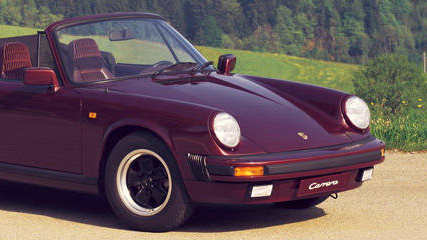
Used Porsche 911 review: 1984-1989
Read the article
By Graham Smith · 03 Jul 2009
The Porsche 911 is a triumph of persistence over perfection. By rights it shouldn’t have worked at all with its air-cooled engine slung out behind the rear axle the way it was, but determined development by Porsche over many years turned the ugly duckling into a graceful swan.Ferdinand Porsche championed the concept of air-cooled rear engines slung out behind the rear axle in a way that led to a pendulum effect when cornering that made his famous VW Beetle and the early Porsches a real handful if pushed to their handling limits.The Porsche family stuck true to Ferdinand’s formula and with endless refinement and improvements in technology made the iconic 911 sports car a true classic revered by petrolheads all round the world.The 911 replaced the 356 in 1964 and the process of evolution was well underway. The 911 3.2 was one of the early signs of what was to come from Porsche; it was bolder, more aggressive and more powerful than the more modest models it followed.Now, almost 25 years old it’s one of the most affordable ways of acquiring a classic Porsche badge.MODEL WATCH In the 1980s Porsche enthusiasts feared the 911 would be killed off by a management determined to enter the mainstream with a series of new models with a water-cooled engine at the front and refined handling of the sort never thought possible with a Porsche badge.The 924 was a rather insipid attempt at appealing to the masses, the 944 was better, while the 928 was a much-underrated supercar. None, however, appealed to the die-hard Porsche enthusiast who couldn’t accept anything but a 911 as a real Porsche.While those front engined models have gone to the great automotive graveyard in the sky the 911 has gone from strength to strength and the company has succeeded beyond even the wildest dreams of the management in charge in 1984 when the 911 3.2 was released.Even today’s 911, a vastly different car to the original 911, has a family resemblance that is unmistakable. Every 911 has retained the 911 ‘look’ even when it’s been heavily altered.The 3.2 looked like a 911, but was subtly different to the cars that went before it. Its lines were bolder than those of its predecessors, and you could have it with the wide body of the Turbo for the ‘Turbo look’.Power came from a 3.2-litre version of the flat six-cylinder engine that was so familiar in the back of previous 911s. It had electronic multi-point fuel injection and electronic engine management and produced a healthy 170 kW and 284 Nm when at its peak. Coupled to a five-speed manual — there was no auto option — it was capable of racing from zero to 100 km/h in 6.1 seconds and had a top speed of 245 km/h.By 1985 exhaust emission limits were having an effect and it was fitted with an air pump. A year later, when Australia went to unleaded fuel the air pump was deleted, but it got a catalytic converter and was detuned to 155 kW.A new stronger gearbox came in 1987, which delivered smoother shifting than the rather stiff shifting Porsche ’box it replaced. At the same time the clutch was changed to hydraulic actuation and the whole gear changing experience was changed for the better. No longer did you need massive muscles to swap cogs, it was a much lighter and more pleasant experience.The following year, 1988, saw engine power boosted to 160 kW with the availability of 95 octane unleaded fuel. Porsche offered the 911 3.2 in a choice of three body styles, coupe, cabriolet and Targa, and in 1985 made the wide body available. In 1987 all were fitted with front spoilers and the wild whale tail rear spoiler.IN THE SHOP Porsches are generally bulletproof, not a lot goes wrong with them even when they get up in the kays as many of them now are. Watch for smoke from the tailpipe under acceleration, which can mean worn bores and oil is getting past the rings. Porsche introduced hydraulic cam timing chain tensioners on the 3.2 and these are much more reliable.The Porsche interior, like all European interiors of the time, suffers under the Aussie sun, and this can lead to cracked and buckled plastics and torn trim. Cabriolets and Targas are more prone to interior damage because of the greater exposure to the sun.It’s important with all cars of the age of the 3.2 to carefully check for evidence of crash damage. The odds of any car of that age being in a crash are high, so it’s worth spending extra time making a thorough check.IN A CRASH Built before the advent of airbags and the like the 3.2 relied on its chassis to get out of trouble. The brakes were powerful, without ABS of course, and stopped the car efficiently. Porsche handling was always the subject of much discussion, and it’s worth getting some experience behind the wheel before pushing the 911 to its limits.AT THE PUMP It’s arguable that a Porsche driver is overly concerned about fuel economy. Most only drive their cars on sunny Sundays and then they rarely go far so the cost of their fun motoring isn’t very high. For what it’s worth the 911 3.2 should get 11-13 L/100 km on average driving, but push it hard and that will markedly increase.LOOK FOR • Porsche cred.• Cheap thrills• Robust mechanicals• Dodge imports• Be wary of modified cars• Great driving fun• Classic Porsche looksTHE BOTTOM LINE It’s almost 25 years old, but the 911 3.2 is an affordable classic that still looks as fresh as tomorrow.RATING 85/100
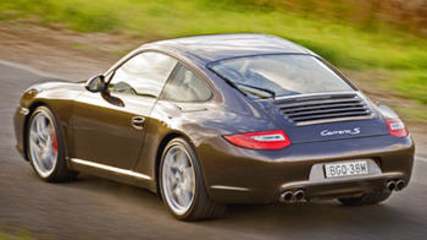
Porsche 911 Carrera 2 S 2009 Review
Read the article
By Neil Dowling · 10 Feb 2009
Why did I go to school? I can mix pool chemicals without needing to understand the hieroglyphics of chemistry.Biology was fun and interesting but I've yet to find the time or inclination to come home after work and studiously slice up a frog.I know that when a violent woman in the shopping aisle pushes her trolley against mine in order to get to the salted crisps first, we're not interested in directional forces and any theory of relativity. Despite me getting relatively angry.So I didn't need physics. Which is just as well.One thought of a car that is basically a pendulum and shouts at all the principles of physics would be enough to make me refuse a ride.Except that in this case the car is from Porsche and the physics lesson was a distant decade, or two — or four — ago.Porsche has stuck its engine out beyond the rear axle since 1948 (though the very first car was mid-engined) and each year its engineers brilliantly mask this unusual layout.This year it's probably relative only to those who hammer Porsches on the track.Owners who test their cars on leafy streets en-route to the office would never know the limits of a Porsche's rear tyre traction.If the car tested here, the Porsche 911 second-generation 997 big 3.8-litre, rear-drive Carrera — in summary, 911 Carrera 2 S — has limits then it rarely showed them. PricingThe 911 Carrera 2 S costs $248,100 but this is a Porsche and the option list awaits.As tested, the car was $258,580 — remember, this is without any on-road costs — thanks to the addition of metallic paint ($1990), the three-spoke multi-function steering wheel that I consider should be standard ($1490) and of course the PDK transmission that you wouldn't want to leave home without. Add a cool $7000 for that gearbox. AppearanceThough externally it appears practically identical to its predecessor, beneath the curvaceous steel body is a whole lot of changes.Externally the second-generation 997 adds LED daytime running lights and tail lights. The Carrera S has quad exhaust pipes.Inside it's business as usual — in this case, well thought out controls in a rather austere environment.Upgrades include a screen monitor for the sat-nav and radio, though controls on the steering wheel are optional. There's more personal storage space than a few models previous but it's hardly cavernous.Though low and occasionally awkward to enter and leave, there is comfortable room for two adults. The rear seats are purely for children and are better flipped forward to boost luggage space from the bin-shaped boot box.That beautiful flowing body shape that so identifies Porsche bites back at the driver by offering zero hint to the placement of the front and rear bumpers. Parking is, at best, a very gentle manoeuvre. Drivetrains and chassisPorsche kept the S engine capacity at 3.8-litres but it's not the same engine as before. It whacks out 283kW/420Nm at higher revs thanks to an improved direct-fuel injection system.This system allows it to breath a cooler fuel-air mixture so the compression ratio has been pushed to a whopping 12.5:1 for maximum efficiency. Most cars are 8:1 or 9:1.There is also a sophisticated on-demand oil pump and scavenging arrangement that saves 2 per cent in fuel and adds the same in power.Power and torque are up though emissions and fuel consumption is down. So impressive was the leap over the old engine that Porsche's next model, the 998, is likely to have smaller-capacity engines that reap equivalent or increased performance with even less fuel use.Aiding navigation down the green route is the PDK dual-clutch transmission. Its seven cogs perfectly match the engine and further help economy.Blisteringly quick in its shifts, the PDK unit is quicker than the old — yet incredibly reliable — Tiptronic box, delivers better acceleration, less fuel use but is a bit heavier. DrivingThe Carrera 2 S's biggest asset is its tractability. The 3.8-litre engine's low-end grunt makes it surprisingly easy to drive and the PDK in auto mode could be just like any other automatic gearbox.That's matched by its responsiveness. Touch the accelerator and this thing's just poised to fire. And it will, so be careful.It's also addictive. The roar of the exhausts and the subdued whirr of the engine's moving metal parts combine with a nose-up stance under acceleration.The steering is direct and, combined with the car's tail-heavy bias, lightens at speed so that imperfect bitumen at high speed makes it subtly — though initially disconcerting — dance. It's something you get used to.Corner speeds can be phenomenal. This car sits flat, shows a bit of understeer and will start to break traction at the rear but is (nearly) always controllable.Things get messy if you lift off the accelerator during hard cornering but that's physics.It can be a bit noisy inside but it's never annoying. Coarse-grade bitumen will make the tyres howl and there's a bit of wind noise around the window at higher speeds.The split-second reaction of the gearshift lever to the manual mode is just glorious but the rocker-shifters on the steering wheel are badly designed, too easy to knock and illogically each combines the up/down shift.But the Bose sound system is delightful, the comfort an absolute surprise (though you can select a firmer ride) and the quality is close to perfect.Above all, it's easy to drive. This is specifically where the Porsche trounces most of its opposition. This is a car that will thrash most other four-wheeled vehicles in performance, yet will happily putter down to the shops and into work.I want one. It's just as well I failed physics. SnapshotPorsche 911 Carrera 2 SPrice: $248,100 ($258,580 as tested*)Engine: 3.8-litre, 6-cyl, direct-fuel injection, quad-cam, variable-valve timingPower: 283kW @ 6500rpmTorque: 420Nm @ 4400rpmFuel economy (official): 10.2 litres/100km, (tested): 11.6 litres/100kmTransmission: 7-speed dual-clutch PDK semi-automatic, sequential, rocker shifters; rear drive
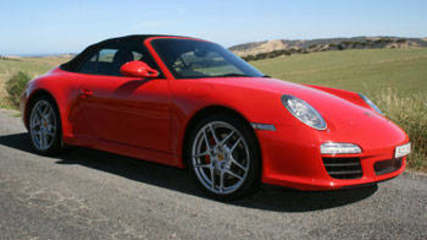
Porsche 911 Carrera S 2008 review
Read the article
By Stuart Martin · 26 Nov 2008
Shimmering white roadsigns adopt a shade of red from the Porsche's reflection and several roads used in the Classic Adelaide are in the immediate future.I don't know who Don Henley is singing about and I really don't care, the '80s song is apt - the new 911 Cabrio likes to dance on some of our great roads and it has fast and light feet.Despite being 30kg heavier than the manual, the new double-clutch PDK is 0.2 sec faster to 100km/h and it will hit 160km/h in 10 seconds flat - the manual is 0.3 of a second behind, but it's a good demonstration of how quick the changes are in the PDK.The Porsche PDK option - short for Doppelkupplung - is a $7000 seven-speed automated manual and is probably the best of the double-clutchers sampled so far.Six of the seven gears are closer-set and keep the flat-six singing in the meat of its rev range, 7th is the fuel-saver cruising gear.The gearbox can be manually shifted using the lever or buttons on the wheel - no paddles for Porsche - but the only problem with the spoke-mounted buttons is the heel of the hand can sometimes inadvertently change cogs.That said, the changes are lightning quick and smooth, although sometimes getting away from a slow-rolling to a standstill, there's a slight hesitation as the gearbox decides on 1st or 2nd.The gearbox is excellent at helping the 3.8-litre direct-injection flat-six sing beautifully, but the boxer engine is also remarkably flexible.Variable valve timing and lift, as well as a tricky intake manifold, help the 911 deliver 420Nm of torque - Porsche says almost 360Nm is available from 2500rpm and that's backed up by the drive experience.The intake manifold has what Porsche calls a "two-stage resonance intake system" which uses the vibration of the air as it passes through the intake manifold to increase the volume of air taken in.It adjusts according to engine speed and the Stuttgart boffins say the system offers higher torque at low engine speeds and a flatter torque curve.Slipping into the optional sports seats, firing up the flat-six and slipping the PDK into D, dropping the soft-top and heading for the hills, it's a form of automotive witchcraft that the 911 offers such sweet steering and manic abilities through the corners.Despite having a rump with more heft than any bootylicious Hollywood types, the 911 rips out of corners with scant regard for weight distribution.Hit sport mode on the adaptive dampers and the 911 is even harder - in all senses of the word - through corners, but bumpy stuff means normal mode is better for compliance.The gearbox - even in D for drudgery - quickly picks up on the driving attitude and adopts appropriate shift patterns.Apparently the optional Chrono Sport package gives the Carrera 2 a sharper edge, but we're not complaining about the drivetrain on this one.The back seat is useful only for baggage, as the backrest is perpendicular and would qualify as cruel and unusual punishment for passengers.A lockable storage unit would probably make more sense, particularly given the 135-litre luggage compartment in the nose.The features list is nothing to complain about, with Bluetooth, satnav, climate control, dual front and side airbags, stability control, adjustable dampers, dynamic bi-xenon headlights and sensational brakes (even before you tick the ceramic composite option box).Make no mistake, the icon that is Porsche 911 might well have been only subtly re-designed from an aesthetic viewpoint, but the mechanical package sets a new benchmark.
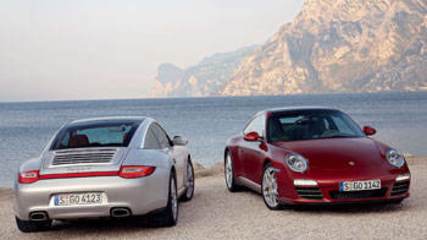
Porsche 911 Targa 4 and 4S 2008 review
Read the article
By Paul Gover · 18 Oct 2008
All companies like to talk about a record turnover, one that is usually reflected in sales and profits.But Porsche has done it differently. Its new record is reflected in the latest full family of 911 models.The arrival of the newest 911 Targa means Porsche has completely renewed its core models with a Series II update that brings everything from direct fuel injection to a PDK double-clutch gearbox in less than six months.That is about one-third of the time it usually takes to renew a 911.It reflects strong global demand for the German sports car icon and the need to clear next year for the arrival of the important new luxury Panamera and a preview of the second-generation Cayenne SUV.Porsche found some late-season sunshine on the shores of Lake Garda in northern Italy to roll out the glass-roof Targa, which picks up all the latest 911 update gear, including a more effective sliding fabric cover.It is the only hatchback in the 911 range, and uses a Targa system that operates as a continuous glasshouse from the top of the windscreen to the engine cover. The roof panel drops and slides back inside the roof in a sweet piece of electric engineering.The Targa comes as one of the most heavily loaded models in the 911 range. It is sold only with all-wheel drive and Porsche's wide-body rear end. That means an Australian starting price of $258,600, though that's likely to rise before the first of the Series II cars lands next year.The Targa is expected to snare 10 per cent of 911 sales in Australia.“This is one of the most attractive 911s. It is the perfect combination,” 911 development chief August Achleitner says.The basic Targa 4 comes with 254kW from its 3.6-litre engine. The 4S jumps to 283kW with its 3.8, though fuel use is as low as 10.6 litres/100km in combined testing, despite a top speed of 297km/h.DRIVINGUnless you look up, you'll never know you're in the Targa.Only when you see the glass roof, which is easily disguised by the more-effective new sun blind, do you remember the latest 911 is not another super-tight Carrera coupe.The Targa feels as taut as the coupe and just as responsive, with the sort of grip and balance Porsche has done well to install with the latest all-wheel-drive package for the 911.Another run with the PDK robotic manual is great too, with slick quick shifts and the potential for race-style cornering if you go for the super-sports program.The Targa 4 is more than quick enough, but a switch to the 4S uncorks the extra 3.8-litre urge that makes every 911 a memorable drive.Still, the PDK shift buttons on the steering wheel are not easy to use. And the manual change for the gearshift is set wrong-way-round for sports driving.The roof itself is easy to use and gives plenty of choices in sunshine and fresh air. It creates some buffeting if it is not open all the way, but if you adjust it for the speed and conditions it works smoothly and elegantly.The hatchback rear end is particularly good, giving more headroom for the back seats, a convenient way to load shopping or children, and an extra 25 litres of storage space.The Targa is good to drive, looks very good and comes fully loaded.But that is the bad news. The combination of a wide 911 body and all-wheel drive makes it one of the dearest in the 911 catalogue.
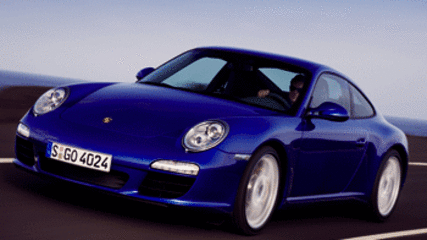
Porsche 911 PDK 2009 review
Read the article
By Neil Dowling · 11 Sep 2008
The sheep, hidden from view by the crest, looks up from the road at the same time the Porsche driver has a clear view of the animal from over the road's brow. Both freak out.The sheep goes one way and then back again, like Dancing With The Stars NZ-style, to the horror of the driver who's now trying to crush the brake pedal into the firewall. The only one unfussed by all this is the Porsche.In a millisecond it drops from sixth to second and, urged by the crushing weight of the driver's right foot, enables ABS, brake assist, electronic stability control and traction control.The subsequent — and alarmingly rapid — deceleration of the Porsche is matched by the sudden acceleration of the sheep out of the danger zone. Here are some of the tools provided by quality carmakers to avoid accidents and save a life or two.The PDK — it's a German acronym meaning dual-clutch transmission similar to theVW/Audi DSG — has the ability to intuitively and rapidly react to driver demands.Porsche has been working on dual-clutch transmissions since the late 1970s, though it aimed to benefit its racing campaigns and was of little interest to street cars.In the early to mid-1980s, PDK-equipped Porsche racers won on the track and the technology was then enhanced, civilised and harmonised with the 911 chassis and engine. This year, it finally sees the showroom.The seven-cog (but six gears in Sport mode) PDK replaces the Tiptronic gearbox and is an option on the 911 range at a $6600 premium to the delightful six-speed manual box.PDK's electronic monitoring means it's immediately compatible with a host of other electronic gizmos so can be made to interact with suspension, brakes, stability aids and most importantly, the engine. Brilliant.So good that it can save a sheep's life.All the eye-blink gear changes used to avoid lamb french cuts have more appealing use on the Symmons Plain race track near Launceston.The driver can attack a corner in sixth gear, stab the accelerator and the PDK snaps into second gear just in time for a power-out corner.The new transmission can be left in D for Drive or punctuated by flicks of the gear lever or steering wheel-mounted paddle shifters.Or, save the $6600 and experience one of the finest gear changes of any rear-engined car.Porsche's latest 10-model 998-series of the perennial 911 — it's now 45 years old — starts at $210,300 for the manual.There are bigger messages all over the latest car. The engine, for example, is a new generation that, from next year, filters into the Boxster and GT2/GT3 models.It shares no components with its predecessor, has 40 per cent fewer parts, lighter and more compact casings, an on-demand oil pump,a semi-dry oil sump to reduce drag and low-friction materials. It weighs 6kg less, has extraordinarily high 12.5:1 compression ratio and uses direct-petrol injection.The result is more power and torque, faster acceleration, less fuel consumption and emissions that better the stringent Euro-5and US LEV-2 levels.It also has 30,000km service intervals to save up to 7 per cent in ownership costs — except in Australia. Apparently our low-grade, high-sulphur premium fuel affects sump oil quality so 15,000km service intervals are specified here.This all skips over the fact this is the most sensational 911 to pilot.Porsche test driver and ambassador Walter Rohrl recently cracked an amazing 7min 56sec lap of the Nurburgring. It's not the production-car lap record (7min 29sec for the NissanGT-R), but it's damn quick for a showroom-fresh 3.8-litre Carrera S with PDK and optional Porsche adjustable suspension.The 3.6-litre 254kW Carrera with PDK leaps to 100km/h in 4.7 seconds, averages 9.8 litres per 100km and has a modest 230g/km of CO2 emissions. In comparison, the 3.8-litre 283kW Carrera S accelerates in 4.5 seconds, drinks10.2 litres per 1000km and has 240g/km.Acceleration feels more impressive than the numbers. The 911 sits low and despite wide wheel arches, the cabin is intimate with simple, glaringly efficient instruments and switchgear. The touch screen is a bonus to people in a rush.Optional Sport Plus accentuates engine and gear shift reaction. Where the standard 911 is as keen as a butcher's knife, the option hones it to razor sharpness. Porsche Active Suspension Management (PASM) changes the action of the shock absorbers and has “normal” or “sport” modes activated by a dash button.But it's not intended for all circumstances. The 911s tend to display their displeasure at rutted bitumen by adopting a tip-toe dance motion. This happens at anything from80km/h to well above posted speed limits. Itcan be unnerving. Best not to grip the steering wheel but let the car find its preferred path and turn off the PASM, Sport or Sport Plus buttons. Back on smoother bitumen, these buttons engage to flatten the ride, firm the nose and tail through the sharpest corners and add razor-sharp gearbox and engine systems.The steering is delightfully well balancedand weighted, positive enough to get the nose precisely where you want even though the bonnet is invisible to the driver.Ride comfort even rates highly — except for gnarly roads when PASM Sport is engaged — making this one of the very few Euro sports cars that combine a weekend thrashing on the track with a Monday morning crawl in traffic.The same applies to the all-wheel-drive 911, the Carrera 4, though this comes with much higher levels of grip and bigger driver grins.The new drive system — from viscous coupling to an electronically controlled multi-clutch — is more positive and adaptable. Up to 100 per cent of power can go to the front wheels. One corner tells you it's a lot better.AWD gives bite, of course, but what really sharpens the teeth is the mechanical limited slip differential that has a 22 per cent lock under traction and 27 per cent in over-run.Carrera 4 and Carrera 4S Cabriolet are at either end of the AWD price list, costing $226,500 and $274,600 respectively as manuals and an extra $6600 for the PDK option.Porsche Cars Australia managing director Michael Winkler is holding three months worth of orders for the new 911. Of those, 80 per cent are for the PDK version.“Tiptronic now accounts for 50 per cent,” he says. “I expect PDK volume to settle to about 65 per cent. The Carrera 4 will do better as there's a tangible benefit in the drive system.”
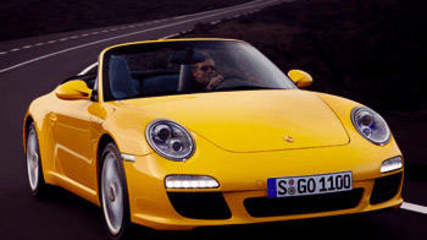
Porsche 911 2009 review
Read the article
By Peter Barnwell · 04 Sep 2008
Car and road are made for each other and we took great pleasure imagining we were Jim Richards carving the curves, leaving the field in a wailing wake of flat six power.The new 911 makes even mug drivers look good.As the mid-model update of the 997 series, the new 911 ushers in a swag of under-the-skin improvements and a mild tweak to its appearance. Blink and you'd miss the body changes which centre on different bumpers, tail lights and headlights and the adoption of an array of LED running lights at the front.Dig deeper and there's been plenty of activity to make the 911 perform and handle better, use less fuel (under 10.0-litres/100km) and deliver more driving pleasure.The 3.6-litre and 3.8-litre engine capacities are retained but both Carrera and Carrera S engines are totally new.“Every screw is new” said Porsche's engineering guru Thomas Krikleberg.“We have equipped the 911 with direct fuel injection for gains in power and fuel efficiency,” he added.“ It also features Variocam Plus (variable cam timing) and a variable oil pump that saves a couple of kilowatts.”A semi-dry sump system is used and the engine internals treated with low friction coatings.The other major development is a double clutch, seven-speed, automated transmission called PDK that consigns the fully automatic Tiptronic 'box to oblivion - at least for 911.Like other automated double clutch manuals appearing on the market, the PDK system offers rapid-fire changes up and down the range, quicker than any manual or auto.For all intents and purposes, these “PlayStation” transmissions make anything else redundant unless you are a stickler for tradition and want a manual.But why would you, manuals are slower and use more fuel.Both flat-six-cylinder engines are naturally aspirated and are good for 254kW/390Nm and 283/420Nm in ascending order. Both can go well into the four-second bracket for a 0-100kmh sprint with the PDK transmission proving that you don't need eight, ten or twelve cylinders and huge power to make a quick car. A few variants of the new 911 Carrera are available including rear wheel drive, all wheel drive and also soft top cabriolet versions of the same. Prices start at $210,400 for the 3.6-litre Carrera coupe manual.The manual is a six speeder and offers a superb driving experience for the purist.But we went all gooey over the PDK especially in the Carrera S with rear wheel drive and Porsche's optional Sports Chrono pack. Apart from other goodies, this offers Sport Plus driving mode at the touch of a button transforming the Carrera S from a hotrod road car into a no-beg-your-pardons track day special.On the drive, the multi-mode suspension system proved a godsend on some of the rougher sections. Normal mode allows the 911 to waft over undulations and potholes in full control with barely a hint of reaction. The steering is absolutely superb, rating as arguably the best in the business and the brakes, even the standard units will bring a blood rush to your head under full application. Bigger multi-piston units and ceramic brakes are available.But it's the way they go that is so satisfying with a Porsche 911. Hit the throttle and it's “see you later.” There's no mucking around, just whoosh, a blood curdling wail and away you go. It's heightened in the PDK Sports Chrono cars that have launch control. Inside has been mildly revised offering plenty of luxury and style as well as leather colour choices and a killer audio system.Wonder how much equity we have in the house?
Porsche 911 C4 and C4S 2008 review
Read the article
By Gordon Lomas · 22 Aug 2008
The gains in fuel economy, performance, reduced weight and emissions are palpable.Yet, as far as exterior giveaways go, the updated 997 Series coupes and cabriolets remain discreet.Just like the Carrera 2 cars which led into the latest update of the 911, the new 4 and 4S, pick up direct injection flat-six engines and Porsche's seven-speed double-clutch gearbox.The big difference is an electronic four-wheel-drive system that replaces the viscous coupling arrangement that has been used on the 911 for almost 20 years.The Carrera 4's new all-wheel-drive system is capable of shuffling torque by up to 100 per cent to either the front or the rear axles if needed where the previous system had limited maximum torque split of between 10 to 40 per cent.Prices and final specifications are yet to be finalised because of the ongoing confusion on the Luxury Car Tax increase, but the new coupes will be in the $220,000-$230,000 range for the C4 and $250,000-$260,000 for the C4S. The ragtop versions are $240,000-$250,000 for the C4 cabriolet and $270,000-$280,000 for the C4S.All will be on sale from October 25, just over a month after the two-wheel-drive versions reach the showrooms.On the outside, Porsche fans daytime running lights at the front, the neat LED rear taillight treatment and a reflector strip on the leading edge of the engine bay lid.Inside, the C4 and C4S offer generational gains with 8.5 per cent more power and use up to 12.9 per cent less fuel while the carbon emissions are lowered by 15.4 per cent.The C4 coupe lifts from 239kW to 254kW yet reduces economy from 11.6litres/100km to 10.1litres/100km with torque rising 20Nm to 390Nm Gains for the 3.8litre C4S are 283kW (up from 261kW) and a reduction in fuel use from 11.9litres/100km to 10.5litres/100km with torque jumping 20Nm to 420Nm.On the PDK gearbox front, Porsche is already hinting it may review what it does for the all-new 998 (unofficial code) model which could be out by late 2010 and which could have proper paddle shifters.The argument against all-wheel-drive layouts continuing to have relevance because of their weight impost hurting fuel economy and performance doesn't ring true in the case of the Carrera 4. Despite weighing 55kg more than a C2, a C4 has lapped Nurburgring's Nordschleife circuit two seconds quicker than its two-wheel-drive equivalent by turning an impressive 7mins 56sec. DRIVING:Changes to what is unofficially called the 997.5 mean this version of the 911 drives with a little more steering feel and less cornering push.On the design front, it's difficult for some to pick the updated Carrera 4 and 4S over the 997 series, but behind the wheel the updated all-wheel-drive 911 coupe and cabriolets are a clear and decisive step forward.On a 170km road drive in the Lowenberger region just outside Berlin, the C4 and C4S were put through a variety of smooth top roads, patchwork bitumen, lumpy and bumpy surfaces and narrow cobblestone lanes.In retrospect it was a brave move. They were not roads that suited the Active Damping set up where ride height is lowered by 20mm in conjunction with the Porsche Active Suspension Management feature.Yet the ride on the super-low-profile 19-inch rubber on the launch cars was not surprisingly jarring. Although at times there was a tendency to pick up every little imperfection and corrugation on the road.The real story is considerable steps ahead in driving dynamics and efficiency.More weight to the steering and the dialing out of some push through corners, together with a brilliant new electronic all-wheel-drive system, gives the new C4 and C4S a sharper edge.There is a triple treat waiting for those interested in the upgraded cars with direct injection and the smart PDK transmission in partnership with the electronic AWD combining to give the C4 and C4S coupes and cabriolets even greater precision and surety.At last a 911 driver can enjoy a truly masterful transmission that finally does justice to one of the sweetest chassis in the business.Pleasing levels of refinement in low speed shuffling around car spaces and rolling away from standstill have been dialed into the new double-clutch PDK. It actually creeps forward from a stop without any throttle and, while there is a bit of grumbling detected here and there when trawling the car park, the PDK is the best example yet of these wet/dry clutch systems.In the Carrera 4 coupe sampled on this drive, the PDK unit had few faults although at times the palms of your hands accidentally pushed the button on the wheel to upshift — particularly if any reasonable amount of steering lock was wound on. It's awkwardly placed and accidentally plucking an upshift is not desirable.With the optional SportChrono system ($2200) you get wildly aggressive shifts when you apply the SportPlus button. The change down from third to second is particularly angry with a short, sharp blip that sends the 3.6-litre boxer engine's into a playful yelp.Even in drive mode the gear selector readout on the Instrument Panel lets you know what gear you are in and the centrally-located taco with digital speed readout strikes a happy combination.It's not until you can legally open the taps that you comprehend what all the fuss is about when driving a 911.A comprehensive drive at a former Russian airfield that saw serious service before the Berlin wall came down in 1989 was an environment made to order for one of the world's most definitive sports cars. The exercises which the C4 and C4S 911s were put through ranged from slalom skidpan runs to long and short handling tracks using ideal lines at maximum throttle and a top-speed blast down a runway.On the slalom the C4 was driven both the stability systems functioning and turned off and the behaviour was, even for an all-wheel-drive layout, worlds apart.The new electronic all-wheel-drive set-up and the lockable limited slip rear differential (22 per cent lockable under power and 27 per cent in overrun) give the C4 tremendous confidence when pushed to the edge.This 911, with its rear-end spread a further 44mm wider than the outgoing model, is so adaptable and balanced that the driver can entice it to behave any way they desire through a corner.Acceleration times with the arrival of PDK have leaped ahead with 0-100km/h achieved in the C4 in 4.8sec, 0.8s quicker than the Tiptronic S transmissionm and 4.5s in the C4S, a similar gain over the previous model. When the optional launch control is applied that cuts the time further to 4.3s.The optional Ceramic Composite Brakes (approx $20,000), 350mm in diameter 20mm more than the standard package are monstrous in performance. After flying down a V-max run, and clocking close to a tick under 260km/h, you can punish the brake pedal as hard as you can muster and the car will pull up without any theatrics.
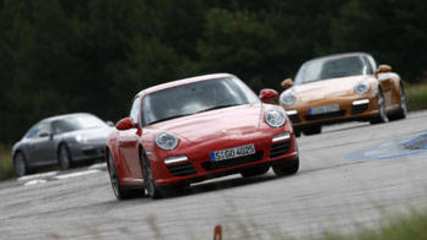
Porsche 911 2008 review
Read the article
By Gordon Lomas · 10 Aug 2008
And those changes have enabled some of the biggest leaps forward in the 40-plus year history of the world's most enviable sports car.The gains in fuel economy, performance, reduced weight and emissions are palpable.As far as exterior giveaways go, the updated 997 series coupes and cabriolets remain discreet unlike the story hidden beneath. DRIVETRAINSThese machines gain direct injection flat six cylinder engines in 3.6-litre (Carrera 4) and 3.8-litre (4S) and an electronic four-wheel-drive system that replaces the viscous coupling arrangement that has been used on the 911 for almost 20 years.And as with its two-wheel-drive brothers, the C4 versions benefit from the seven-speed double clutch transmission called Porsche Doppelkupplungsgetriebe or PDK.While there are seven gears, the first six ratios are evenly spaced with the final cog essentially an overrun for better economy and emissions.Bristling with engineering advancements, the C4 and C4S offer generational gains with 8.5 per cent more power and use up to 12.9 per cent less fuel while the carbon emissions are lowered by 15.4 per cent.The C4 coupe lifts from 239kW to 254kW yet reduces economy from 11.6litres/100km to 10.1litres/100km with torque rising 20Nm to 390NmGains for the 3.8litre C4S are 283kW (up from 261kW) and a reduction in fuel use from 11.9litres/100km to 10.5litres/100km with torque jumping 20Nm to 420Nm.The PDK can either be accessed by the gearshifter or large buttons integrated on the steering wheel spokes which have come in for a deal of criticism for their awkward placement.Already Porsche says it may review what it does for the all-new 998 (unofficial code) model which could be out by late 2010 and which could offer proper paddle shifters as well as the buttons. EXTERIOR AND SPECOn the outside afficianados will notice the definitive daytime running lights at the front, the neat LED rear taillight treatment and a reflector strip on the leading edge of the engine bay lid.At 124kg the PDK unit, which is expected to command a $7000 option price, is just over 10kg lighter than the Tiptronic S unit it replaces but is 30kg heavier than the manual gearbox.The PDK unit shares little with save for the in-principle idea of twin clutch technology, which Porsche used on its brilliant 956 Group C sports car racing programme of the early 1980's.As a $2200 option, the Sports Chrono Package Plus system incorporates a launch control feature that is accessed by a SportPlus button that automatically dials up 6500 revs for the perfect getaway.Another feature of the package is a meaner, angrier gearshift map accessed by the SportPlus button.Sports Chrono also enables the driver to keep a log of their lap times and detect if you are slower or faster on any given lap.SportPlus literally changes the personality of the PDK gearbox into an explosively response weapon where the shortest, sharpest gearshift points are accessed with shirt times claimed to be twice as fast as the outgoing Tiptronic S.The argument against all-wheel-drive layouts continuing to have relevance because of their weight impost hurting fuel economy and performance doesn't ring true in the case of the Carrera 4.Despite weighing 55kg more than a C2, a C4 has lapped Nurburging's Nordschleife circuit two seconds quicker than its two-wheel-drive equivalent by turning an impressive 7mins56sec.The Carrera 4's new all-wheel-drive system is capable of shuffling torque by up to 100 per cent to either the front or the rear axles if needed where the previous system had limited maximum torque split of between 10 to 40 per cent. DRIVINGTraditionally Porsche refrains from fiddling too much with the design clarity of the time-honoured 911.There's good reason because the proportions, lines, swoops and curves are among the purest and prettiest in automotive car design.No surprise then at a casual glance it's difficult for some to pick the updated Carrera 4 and 4S over the 997 series.So 997.5, as we define it, offers mild styling changes with front and rear head and taillight LED and a red reflector at the back that returns over 10-odd years of non-service.Behind the wheel the updated all-wheel-drive 911 coupe and cabriolets are a clear and decisive step forward.On a 170km road drive in the Lowenberger region just outside Berlin, the C4 and C4S were put through a variety of smooth top roads, patchwork bitumen, lumpy and bumpy surfaces and narrow cobblestone lanes.In retrospect it was a brave move putting the firm Carrera 4 coupe and cabriolet over those challenging conditions.They were not roads that suited the Active Damping set up where ride height is lowered by 20mm in conjunction with the Porsche Active Suspension Management feature.The ride on the super low profile 19-inch rubber that the launch car was shod with was not surprisingly jarring.At times there was a tendency to pick up every little imperfection and corrugation on the road.That said the real story is that the face-lifted car shows considerable steps ahead in driving dynamics and efficiency.More weight to the steering and the dialling out of some push through corners together with a brilliant new electronic all-wheel-drive system give the new C4 and C4S a sharper edge.There is a triple treat waiting for those interested in the upgraded cars with direct injection and the smart PDK transmission in partnership with the electronic AWD combining to give the C4 and C4S coupes and cabriolets even greater precision and surety.At last a 911 driver can enjoy a truly masterful transmission that finally does one of the sweetest chassis's in the business justice.Pleasing levels of refinement in low speed shuffling around car spaces and rolling away from standstill have been dialled into the new double clutch PDK 7-speed transmission.It actually creeps forward from a stop without any throttle and while there is a bit of grumbling detected here and there when trawling the car park, the PDK is the best example yet of these wet/dry clutch systems.In the Carrera 4 coupe sampled on this drive, the PDK unit had few faults although at times the palms of your hands accidentally pushed the button to upshift particularly if any reasonable amount of steering lock was wound on.It's awkwardly placed and accidentally plucking an upshift is not desirable on a track day or tarmac rally when you're negotiating quick direction changes.Together with the optional SportChrono system ($2200) when you apply the SportPlus button the gear shift points become more wildly aggressive.The change down from third to second is particularly angry with a short, sharp blip that sends the 3.6-litre boxer engine's into a playful yelp.Even in drive mode the gear selector readout on the Instrument Panel lets you know what gear you are in and the centrally located taco with digital speed readout strikes a happy combination.It's not until you can legally open the taps that you comprehend what all the fuss is about when driving a 911.A comprehensive drive at a former Russian airfield that saw serious service before the Berlin wall came down in 1989 was an environment made to order for one of the world's most definitive sports cars.The Gross Drolln airfield is a huge base linked by a maze of concrete runways flanked by dozens of camouflaged steel and concrete bunkers once home to MiG fighter jets ready to wage a war that thankfully didn't happen.Porsche used the airfield a few years ago to launch its Carrera GT supercar so it's no mickey-mouse deal for pretend sports cars.Among the extensive network of runways and link roads there are two dedicated handling tracks, a skid pan and a 1.7km long runway for high speed testing.The exercises which the C4 and C4S 911s were put through ranged from slalom skid pan runs, long and short handling tracks using ideal lines at maximum throttle and a top speed blast down the runway.Apart from being more fun that being locked in a room full suffocating with laughing gas, the exercises proved several points.On the slalom the C4 was driven both the stability systems functioning and turned off and the behaviour was, even for an all-wheel-drive layout, worlds apart.It then begs the question why traction and stability aids like Porsche's PSM should be switchable in lesser marques than those from Zuffenhausen.The new electronic all-wheel-drive set-up and the lockable limited slip rear differential (22 per cent lockable under power and 27 per cent in overrun) give the C4 tremendous confidence when pushed to the edge.This 911 with its rear-end spread a further 44mm wider than the outgoing model, is so adaptable and balanced that the driver can entice it to behave any way they desire through a corner.With small adjustments on the tiller and the throttle you can smooth out understeer mid-corner and gain maximum punch for the exit.Acceleration times with the arrival of PDK have leaped ahead with 0-100km/h achieved in the C4 in 4.8sec, .8s quicker than the Tiptronic S transmission and 4.5s in the C4S, a similar gain over the previous model.When the optional launch control is applied that cuts the time further with a 4.3sec acceleration time from a standstill to 100km/h.The optional Ceramic Composite Brakes (approx $20,000), 350mm in diameter 20mm more than the standard package are monstrous in performance.After flying down a V-max run and clocking close to a tick under 260km/h, you can trample the brake pedal as hard as you can muster and the car will pull up without any theatrics.In that exercise there is a massive amount of force generated by the emergency stop that is said to be the equivalent of about 1800bhp.
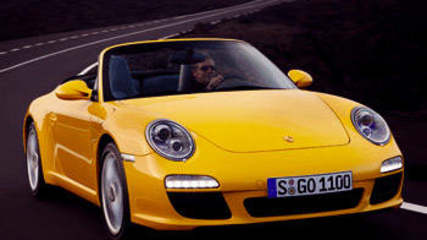
Porsche 911 Carrera 2008 review
Read the article
By Peter Barnwell · 17 Jun 2008
The iconic shape of Porsche's 911 is unmistakable even though it has been evolving since the first prototype, hand built by Ferdinand Porsche, back in 1948.
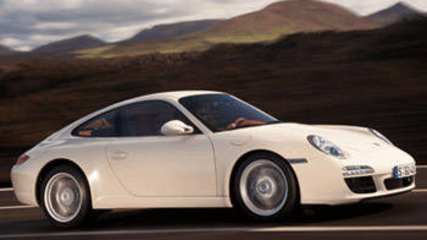
Porsche 911 Carrera PDK 2008 review
Read the article
By Kevin Hepworth · 16 Jun 2008
It has been on the workshop bench for more than a quarter of a century, now finally Porsche is ready to share its Porsche-Doppelkupplungsgetriebe gearbox with its legion of daily drivers.




